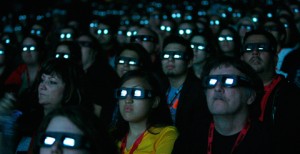I have a confession to make. I’m a little confused by one of the themes we’re already seeing from the 2010 Consumer Electronics Show: 3-D Televisions.
Before the C.E.S. announcements began rolling out Tuesday I expected to read a lot of interesting press releases about fancy new televisions. I did not foresee the majority of these announcements starting with the words “3-D TV.” It seems every major TV manufacturer is involved, in one way or another, with trying to entice consumers to purchase this new experience in their living rooms. Device manufacturers including Sony, Panasonic, Toshiba and LG are all announcing 3-D-enabled TV’s at C.E.S., and content companies plan to start making movies and TV shows for these 3-D experiences. As Brian Stelter reported today on the Media Decoder blog, Discovery, Sony and Imax announced a joint venture to deliver the first dedicated 3-D television network in the United States.
Device manufacturers including Sony, Panasonic, Toshiba and LG are all announcing 3-D-enabled TV’s at C.E.S., and content companies plan to start making movies and TV shows for these 3-D experiences. As Brian Stelter reported today on the Media Decoder blog, Discovery, Sony and Imax announced a joint venture to deliver the first dedicated 3-D television network in the United States.
So here’s the C.E.S. 2010 pitch for your living room: Imagine sitting back on your couch with a big bag of popcorn, watching the movie “Avatar,” a football game or two great white sharks voraciously attack each other on the Discovery Channel, all in 3-D.
Here’s the reality: Imagine having to pay another two or three thousand dollars to replace the crystal clear high-definition flat-panel TV you just bought at Christmas (for a third of the price). Then imagine having to watch any of those aforementioned shows or movies while wearing a pair of $50 3-D glasses. Then having to buy another five or more pairs of $50 3-D glasses for family members or friends to watch TV with you.
I’m not against 3-D televisions, I’m just weary of the actual viewer experience. I’m sure there are plenty of scenarios that would make this experience extremely immersive and fun. Video games come to mind — playing Call of Duty on my Xbox in 3-D could drench the experience in an unimaginable reality. But I really can’t imagine inviting a group of friends over for hamburgers and beers to watch a Yankees game, then handing them a pair of 3-D glasses as I greet them at the door. Do I have to take the glasses off each time I go to the grill to check on the burgers? And what happens when I want to watch shows like “Seinfeld,” or “Everyone Loves Raymond”? Will I really want to experience these in 3-D too?
Joshua Greer, president and co-founder of RealD one of the 3-D technology companies that made projection systems and glasses for “Avatar,” believes 3-D TVs are going to be the only TV option in the future. Mr. Greer explained that a large portion of Americans will have a 3-D TV at home. “I don’t think there’s a TV manufacturer in the world that will create and sell a TV without the 3-D chips built in,” he said. He thinks movies, sports and other special venue events will entice people to try 3-D in the home. “And gaming is going to be a huge experience for consumers,” he said.
One of the potential consumer problems with the 3-D TV experience is being forced to wear 3-D glasses. To tackle this problem, there are other 3-D technologies, one called Auto Stereo Display, which will allow glasses-less 3-D viewing. But because of technology limitations you’re forced to sit at certain distance and angle to the the screen. If you’re off by a few feet the entire experience is lost. Mr. Greer says we will eventually get to a point of glasses-less 3-D viewing, but we are two to three years away. “In the short term, we’re in a glasses universe,” he said, “to go to a truly glasses-less world we need much better TV glass technology. You will see more of these experiences in shopping malls, but as far as in-home viewing, it’s going to take a little while before we see the glasses-less vision experience.”
The 3D@Home Consortium, a group developed in 2008 with the goal of speeding 3-D TV into homes, also hopes 3-D TV is here to stay. Rick Dean, the director of the consortium, said consumers won’t have a choice about buying a TV with 3-D in the coming year. Between manufacturers and content creators, the industry has spent billions of dollars getting ready for this next wave of home 3-D televisions. He said, “I think we’ve come to the end of the HD conversion. I’d say that technology is fairly well baked, the next big thing is about an enhanced experience into the home.”
Maybe the consortiums and TV manufacturers are right, we’ll see these images popping out of our TVs in our homes and never look back to a 2-D world. But I’m about as geeky as they come, so are most of my friends. We all wait in line for the latest iPhones or video games and we spend an exorbitant amount of time sharing links about the latest digital cameras, video game consoles and the Apple rumors. But I can’t recall a single geeky friend saying anything, with any excitement, about 3-D televisions.
By NICK BILTON



Pingback: Google May Offer Voip Service – Technology, Iphone, Mobiles, Nokia …